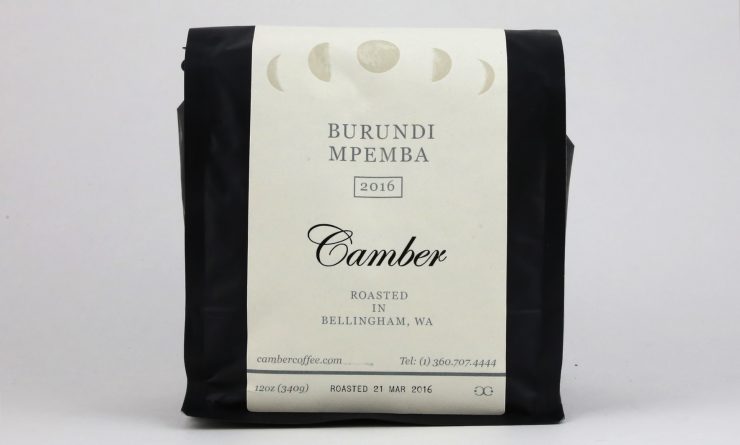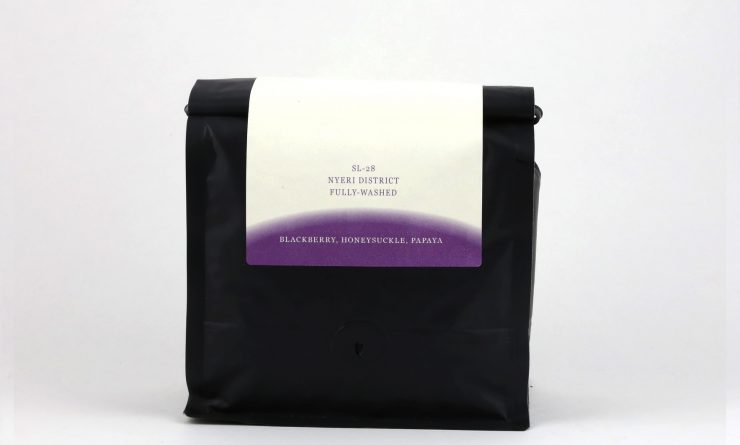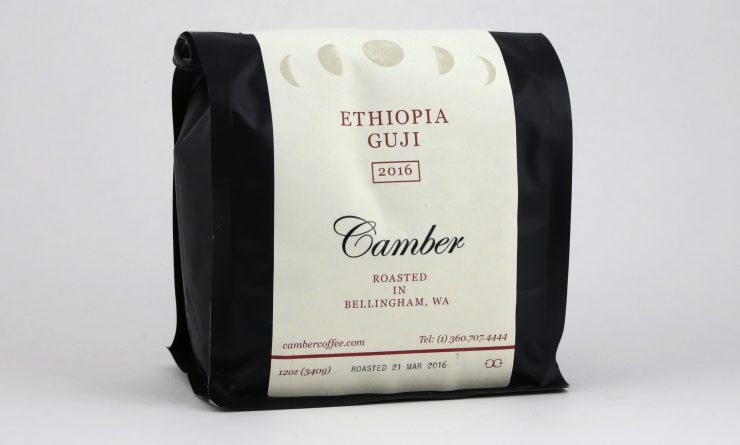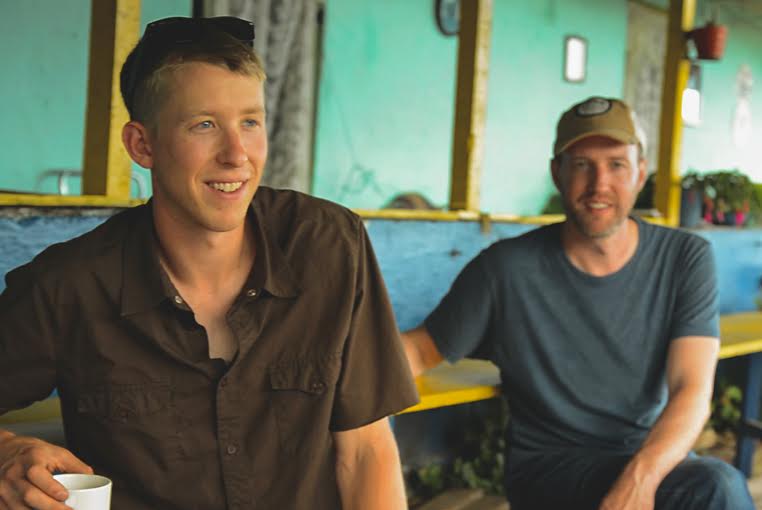What does it mean for a brand to come out of nowhere? Or out of Bellingham, Washington?
It’s been a whirlwind first six months for Camber Coffee, a new microroasting coffee project from David Yake, Andrew Bowman, and Todd Elliott. Hatched in the belly of a cocktail bar—The Real McCoy in Bellingham—the first bags of their sophisticated, well-received coffees dropped in the winter of 2015, and the roaster has slowly begun building a roster of clients around the United States. Camber, who are advertising partners of Sprudge, have quietly amassed an esteemed following both in the Northwest (including being served at Canlis Restaurant, Analog Coffee, and Royal Drummer, all in Seattle) as well as at high-profile shops like Cognoscenti Coffee, G&B Coffee/Go Get Em Tiger in Los Angeles, Mazarine Coffee in San Francisco, and Barista in Portland, Oregon.
Andrew Bowman’s background is in dining, and he’s a culinary school graduate. David Yake got his start as a barista at Parnassus Cafe on the campus of the University of Washington in Seattle. And Todd Elliott is a second-generation coffee professional with three decades in the business. They met as part of the team at Tony’s Coffee in Bellingham, where Bowman and Yake have stacked up accolades over years of work together, including a first place win in the 2014 Roasters Choice Competition at SCAA for Bowman, and a third place finish for Yake at the 2014 US Cup Tasters Championship.
Camber means, simply, “curve”, a reference to the “roast curve” coffee roasters use to track the development of green coffee as it slowly turns brown under heat. Their logo has been adapted from A Handbook on Arabica Coffee in Tanganyika, a 1960s coffee agronomy textbook given to them as a gift by John Gibb, owner of the Willows Inn on Lummi Island, where Camber is also served. More on them later.
Yake and Bowman are the young bloods, while Elliott is the old hand—he’s been their boss over the last several years at Tony’s, where he’s the President and CEO. In some ways it’s a familiar story: young’uns at an established coffee company (Tony’s launched in 1971) yearn for something of their own, so they break away and do their own thing. Except instead of the usual storyline—boss finds out, boss gets mad, the dreamers ship out—Yake and Bowman brought their boss in on it. While all three remain tied to Tony’s, Elliott’s allowed the team to incubate the Camber micro-brand within Tony’s facility, and he’s even an investor.
“I guess I didn’t want to miss out,” Elliott tells me of his decision to help his employees’ coffee dreams. “Andrew and David, they’re family. I want for them to realize their potential, to follow their passions. And to be honest, I knew they were going to do this one way or the other…with or without me.”
For a seasoned professional (in any industry), a move like Elliott’s belies some degree of humility—but he’s savvy enough to know it’s also smart business. “Their success is my success,” Elliott says. “When I look back at my coffee career—and I’m well into the second half—one of the things that will matter most to me is how I was helpful to the development of the people I’ve worked with. The ripple effect…that’s how you can actually make a meaningful difference in the world.”
With improved access to green and less focus on the trappings of scale, are microroasters the future of coffee quality?
One person who thinks so is Charles Babinski, the American barista champion and proprietor, along with Kyle Glanville, of G&B Coffee and Go Get Em Tiger in Los Angeles. His cafes are inarguably two of the country’s best, and they follow a kind of modified multi-roaster model: featured roasters can come from nearly anywhere in the world, but the espresso menu is anchored by offerings from 49th Parallel, in Vancouver, British Colombia. Babinski–whom Yake describes as “one of the most generous people in coffee”—was an early champion of Camber, and having their coffees placed in his cafes after just a few months in business was a total coup.
“What Camber is doing is really special,” Charles Babinski told me over a Facetime chat from Korea. “It’s cool because small roasters used to have to suck for a long time to get good, but that isn’t true anymore. It used to be that the big specialty coffee companies had the keys to the kingdom—the direct relationships, the alchemical knowledge of roasting—but now, with the rise of good green importers and an analytical approach to roasting, a lot of the small companies are on par with the big guys, or actually better.”
And for an industry that’s walked a fine line between insisting on top quality and fetishizing small-scale craft—and often had to choose between the two—the more ready synthesis of these is a new moment. Babinski sees an argument for tiny brands like Camber buying high-quality green and paying careful attention to how they develop it. “The idea that for a brand like Camber, the first few roasts they put out as a business being something we’d want to buy…it’s just really cool,” Babinski told me.
That sound you hear is every small roaster in America nodding their heads in unison.

So how then, does a young and unknown coffee roasting company get picked by Glanville & Babinski? “They just sent us some samples,” Babinski said, matter-of-factly. His team in Los Angeles receives a torrent of samples each month from enthusiastic roasters around the country, and they cup and evaluate them all. “When one stands out that’s good, we send a follow-up, and with Camber we felt like…it’s not just good, it’s a type of coffee we can sell.” For Babinski that also meant a coffee that is not a light-roasted, Scandinavian-influenced, trend-chasing tea-like brew. Indeed, it means just the opposite. “Camber’s coffees are rounder, fuller, and they taste good,” he explained.
For his part, roaster Andrew Bowman sees a more profiled, fuller approach to roasting as a matter of intentionality—not just about eschewing those super-Scandi-style coffees. “My roasting approach is focused on bringing out sweetness, balance, and flavors that are unique to that particular coffee,” says Bowman—and it’s an approach that has clearly connected with many beyond Babinski.

So if the little guys—Nelsonville, Wisconsin’s Ruby Coffee Roasters come to mind—have leveled the playing field, and microroasters can access the same high-quality coffee, pay meticulous attention to roasting, and put out a product that rivals any larger coffee brand, then logic demands an evaluation of the fixed costs. Green coffee costs the same if you’re in Brooklyn or Bellingham, but rent most assuredly does not. These days, to be a great coffee roaster, not only don’t you have to be in a major city, it probably behooves you to not be in one. None of this coffee is grown in Los Angeles, or New York City, or Chicago, or Austin, anyway, but the rent you pay to roast and operate is tethered to the local market. The rise of the small town microroaster is a logical extension of the specialty movement.
Bellingham isn’t quite central Wisconsin, though—a couple hundred thousand people live here, and there is a big state college, Western Washington University, where I went to several years of nerd summer camp as a teen. I wouldn’t call Bellingham a foodie destination—the burritos at Casa Que Pasa not withstanding—but for one major exception: Willows Inn, on nearby Lummi Island, part of the stunningly gorgeous San Juan Islands chain.
Michelin don’t come this way yet, but when that changes expect a star or three for chef Blaine Wetzel at the Willows. An apprentice of Rene Redzepi—whose Noma restaurant in Copenhagen has helped define what it means for a modern dining room to care about coffee—Wetzel is a two-time James Beard Award winner, pulling off a rare back to back victory as Rising Star Chef Of The Year in 2014 and Best Chef for the Northwest region in 2015. After your geoduck charred with kelp, Dungeness crab in pureed pine nuts, and spring lamb with meadow grasses, you can look forward to a cup of Camber Coffee, brewed on a Ratio Coffee Machine.

Willows’ owner, the aforementioned John Gibb, actually grew up on a coffee farm in Tanzania—but that’s quite literally another story for later this year. He and Wetzel attended a series of intimate cuppings with Camber in Bellingham, “and the coffees won them over” says Yake. From there the Camber team has been closely involved in the evolution of the coffee program at Willows, a program that does justice to the extraordinary food served there. “I’ve spent a lot of time working with their staff,” Yake says, “and it’s always inspiring to see the complete buy-in they get from every single member of their team.” It’s a sentiment we’ve heard echoed by coffee pros lucky enough to work with professional restaurant staffs, including back at Rene’s place.
Camber is still, strictly speaking, a tiny, new coffee roasting company. They still share space with Tony’s up in Bellingham, which has been an important advantage in moving forward. I asked Yake if they’d someday be opening their own Camber Coffee bar, because isn’t that what’s supposed to happen next? Maybe not. “We’re constantly dreaming about opening our own space,” Yake admits, “but for now we’re focused on making sure every roast is spot-on and providing the best service we can to our wholesale customers.”
For what it’s worth, Camber feels the growing pains. “When you have something new that you’re wildly excited about, there’s a lot of temptation to climb on the roof and shout and throw coffee at everyone below,” David Yake tells me. “But that wouldn’t be the best idea for a variety of reasons. We’re constantly reminding each other of the need to do things right, even if that means it takes twice as long.”
“We have the luxury of being patient,” says Todd Elliott, and you can practically taste it in their coffee. Enjoy Camber’s little secret while you can, coffee drinkers. Stuff like this only stays small for so long.
Jordan Michelman is a co-founder and editor at Sprudge.com. Read more Jordan Michelman on Sprudge.
The post Camber Coffee And The New Curve Of American Microroasters appeared first on Sprudge.


